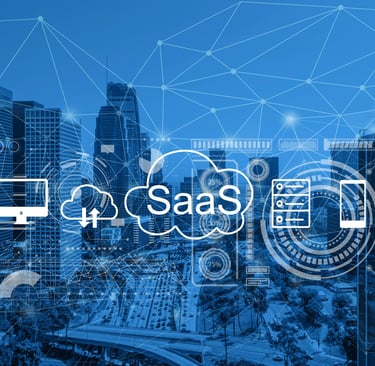Revenue Recognition for SaaS : Managing Subscription-Based Accounting
Revenue recognition is a crucial aspect of financial reporting for Software as a Service (SaaS) companies. Giving recurring billing models and multi-year contracts, determining when and how revenue should be recorded requires adherence to accounting standards. Here are some of the key considerations affecting SaaS companies.
Tanny
6/10/20253 min read


Q1: What is SaaS?
SaaS (Software as a Service) is a cloud-based software delivery model where customers access applications via the internet rather than installing them on their devices. Companies such as Salesforce, HubSpot, and Canvas operate on SaaS models, typically charging subscription fees for their services.
Q2: Why is Revenue Recognition Important in SaaS?
Unlike traditional software sales, where revenue is recognized upon product delivery, SaaS revenue is earned over time since services are continuously provided. Improper revenue recognition can lead to financial misstatements, affecting investor confidence, tax calculations, and compliance with accounting regulations.
Q3: What Are the Relevant Accounting Standards for SaaS Revenue Recognition?
United States (U.S. GAAP - ASC 606)
Governed by Accounting Standards Codification (ASC) 606, issued by the Financial Accounting Standards Board (FASB).
Requires revenue recognition based on five key steps:
Identify the contract with a customer.
Identify performance obligations within the contract.
Determine the transaction price.
Allocate the transaction price to the performance obligations.
Recognize revenue as obligations are satisfied.
Canada (IFRS 15 - Revenue from Contracts with Customers)
Governed by International Financial Reporting Standards (IFRS) 15, which closely aligns with ASC 606.
Similar five-step framework applies.
Ensures standardized revenue recognition across industries globally.
Q4: How Are SaaS Companies Applying These Standards?
SaaS businesses recognize revenue over the subscription period, not upon contract signing or payment receipt. Here’s an example:
Example - Revenue Recognition in a SaaS Subscription
Scenario: A SaaS company signs a 12-month contract with a customer for $24,000, paid upfront.
Recognition: Instead of recognizing the full $24,000 immediately, the company records $2,000 per month as revenue over the 12-month period, ensuring compliance with ASC 606 / IFRS 15.
Q5 How does revenue recognition apply to Multi-Year Commitment?
Scenario: A SaaS company signs a 2-year contract with a client for $30,000 ($15,000 per year), paid upfront.
Revenue Recognition: The company cannot recognize the full $30,000 immediately. Instead, it records $1,250 per month over the 24-month contract period to comply with ASC 606 / IFRS 15.
Example: Enterprise-level SaaS products like Salesforce or Microsoft Dynamics 365 often offer discounted rates for clients willing to commit to multi-year agreements. This means deferred revenue accounting is essential to properly allocate earnings over the contract duration.
Q6 What about revenue recognition for Upgrades (Feature Add-ons or Expansions)?
Scenario: A customer subscribes to a basic CRM SaaS plan for $150 per month on a 12-month contract (total contract value is $1,800). Six months later, the customer decides to upgrade to a premium plan of $200 per month with additional features for the remaining 6 months.
Revenue Recognition: The upgrade fee is not recognized immediately. Instead, the additional revenue of $50 per month from the upgrade is amortized over the remaining six months.
Q7 Are there any different treatment for Tiered Pricing & Usage-Based Plans?
Scenario: A SaaS provider charges customers based on usage tiers (e.g., up to 10 users = $100/month, 11-50 users = $500/month).
Revenue Recognition: The variable pricing structure means revenue is adjusted month-to-month based on actual consumption levels.
Example: Cloud-based accounting software like Xero or QuickBooks uses tiered pricing based on the number of users subscribed. If a business moves from a lower tier to a higher one mid-month, the additional charge is recognized progressively, ensuring compliance with revenue recognition rules.
Q8: What Are the Best Practices for Tracking SaaS Revenue Recognition?
Proper revenue tracking ensures compliance, financial accuracy, and better business decisions. Below are ways SaaS companies can streamline their revenue recognition process:
1. Implement Automated Revenue Recognition Software
Use AI-driven or accounting software like NetSuite, Chargebee, or Zuora to automate revenue tracking and compliance with ASC 606 / IFRS 15.
2. Maintain Detailed Contract & Performance Obligation Records
Use tracking tools like Excel or Google sheet to track contract terms, pricing adjustments, service upgrades, and multi-year commitments. Define each performance obligation and recognize revenue accordingly.
3. Monitor Deferred Revenue & Accrual Accounting Properly
Review and update deferred revenue accounts monthly to reflect earned vs. unearned revenue.
4. Perform Regular Revenue Forecasting & Reconciliation
Forecast revenue based on contract trends, customer retention rates, and expected upgrades. Reconcile monthly actual recognized revenue with reported financials for any discrepancies.
5. Maintain Compliance with ASC 606 / IFRS 15
Review the revenue recognition policies to stay compliant with accounting standards.
6. Leverage AI & Analytics for Revenue Insights
Use AI-driven tools help predict revenue trends, customer churn impact, and billing anomalies.
Tracking SaaS revenue effectively requires automation, compliance, and structured financial processes. By following these best practices, companies can ensure accurate reporting and avoid revenue misstatements.
Contact advisory@thettin.net for additional information.
